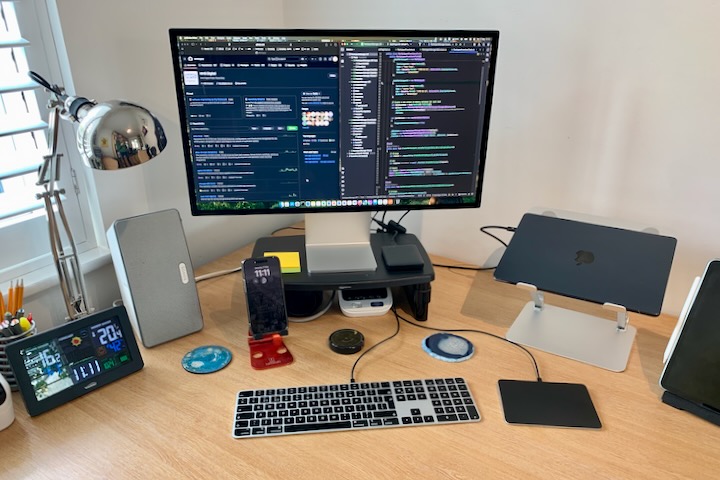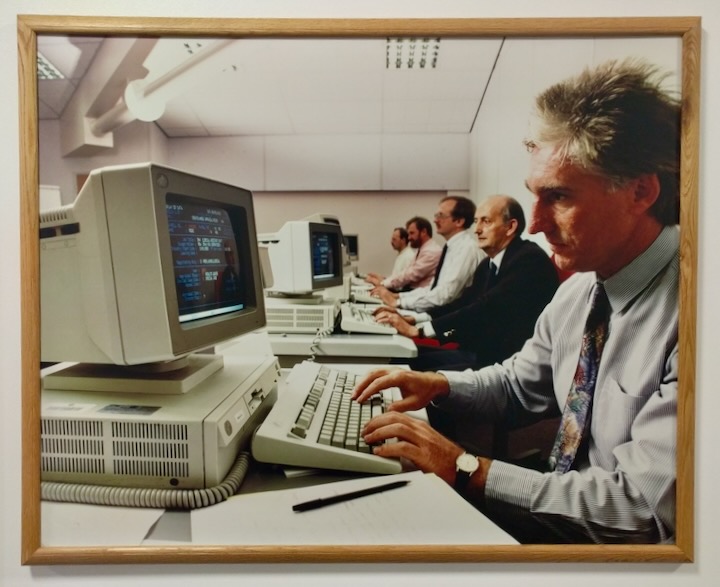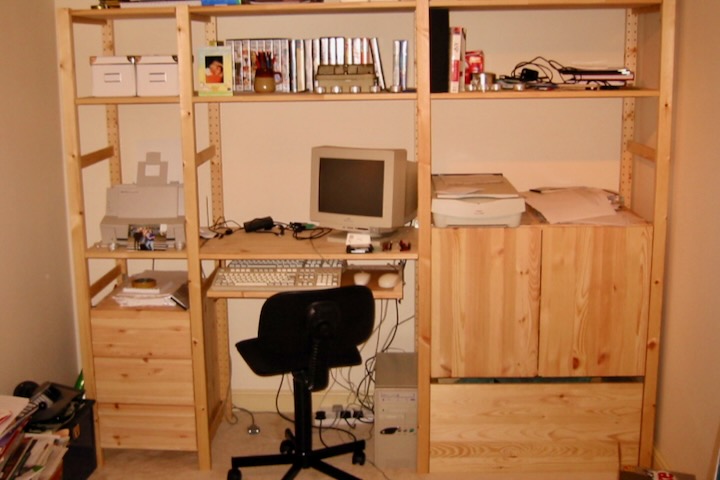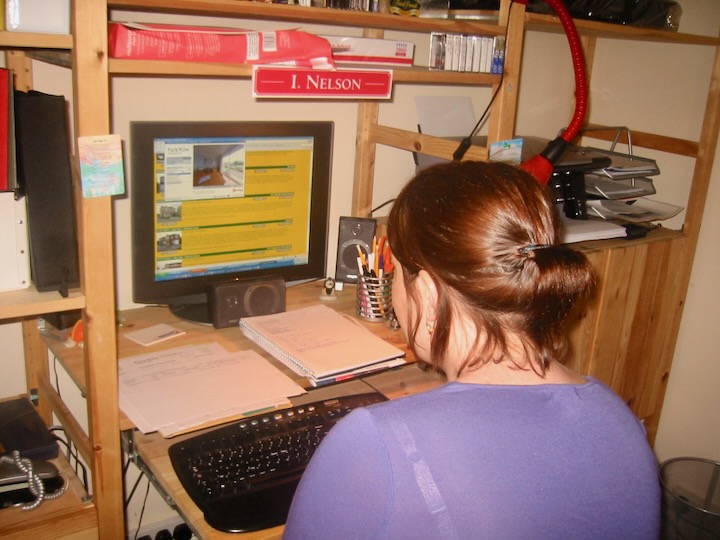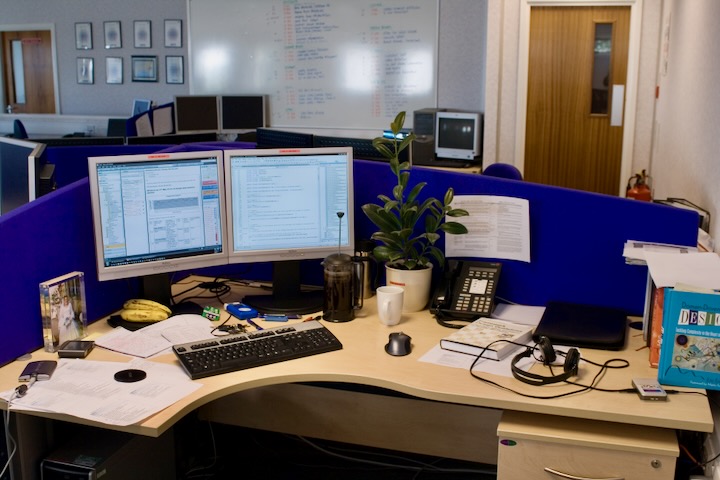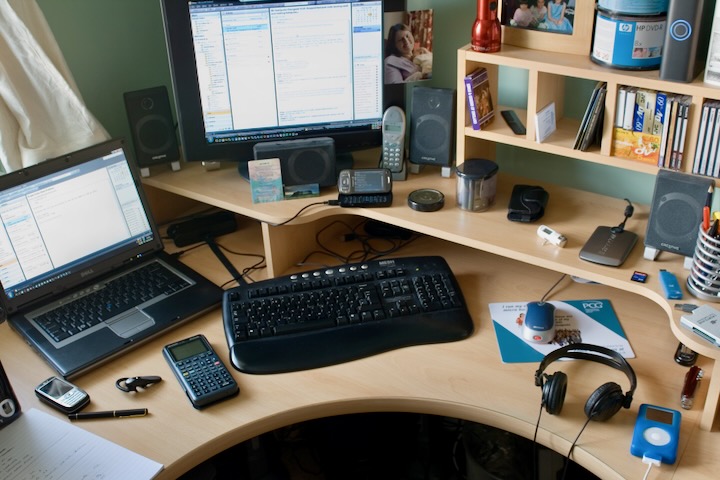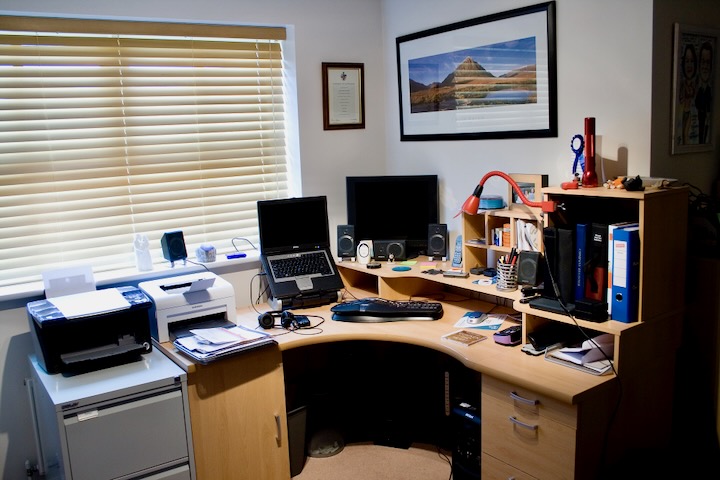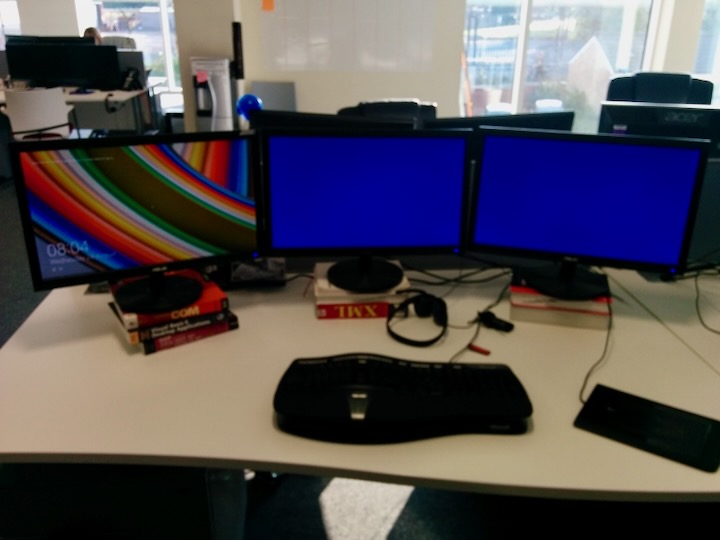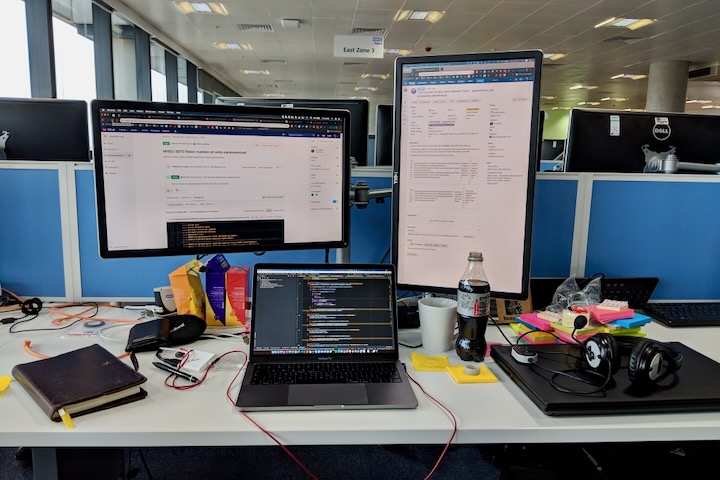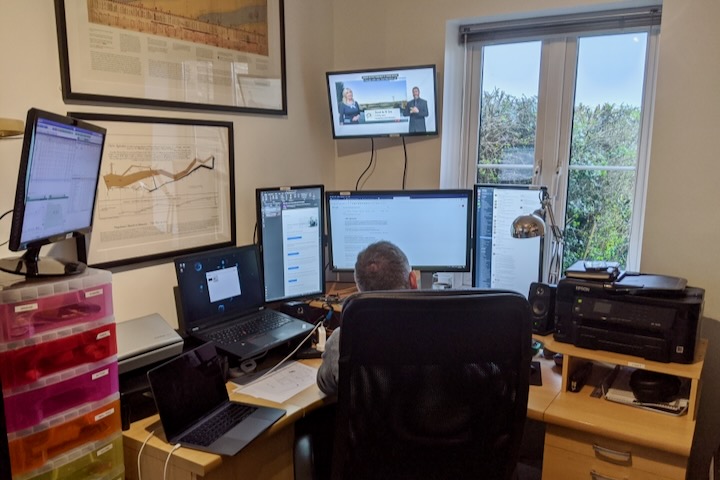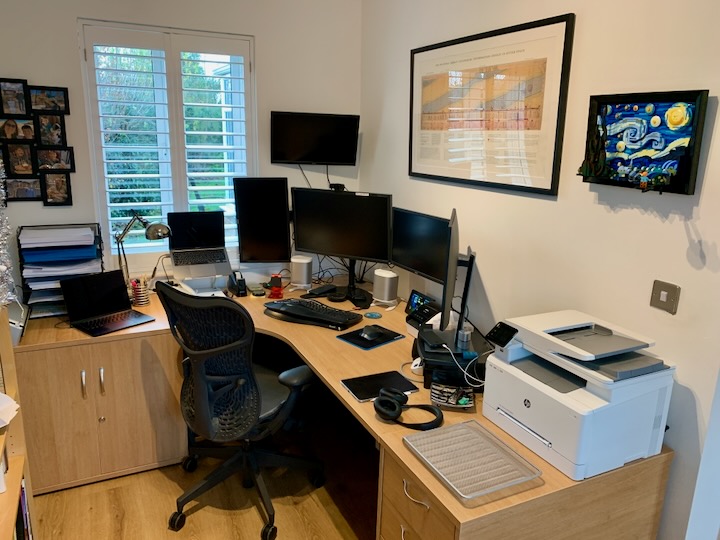There was a time, not so very long ago, when I firmly believed that my productivity was directly proportional to the number of screens on my desk.
One screen? You’re a civilian. Two? Getting serious. Three? Welcome to the big leagues. Four? Now we’re talking. Five? You, sir, are a professional. Possibly even a Bond villain.
For much of my adult life – from 1997 to 2022 — I was on a one-man mission to surround myself with glass rectangles. I wanted dashboards, terminals, Slack, Outlook, scrolling logs, live bond market charts, rolling 24-hour news, and maybe even some code all visible at once, like a NASA flight director minus the buzzcut and the cigarette. I told myself that it was efficient. That more screens meant more throughput. That toggling amounted to waste.
Reader, I was deluding myself.
Let us begin at the beginning.
In late 1997, as a bright-eyed junior developer, I had a single beige CRT monitor perched atop a desktop computer somewhere within a vast open plan office. Its primary purpose was to allow me to connect to an IBM mainframe via a ROSCOE terminal, and therefore I had very little need for more than the most basic of single screens. I had no access to the World Wide Web, and could only send and receive emails to others within same organisation. I felt like a battery-farmed software developer.
Sadly (or perhaps not), I don’t have any photographs from the office environment in which I began my career. Digital cameras were still several years away from being mainstream, mobile phones were still a curiosity, and banks like the one I worked in would have been somewhat suspicious if I had started taking snapshots of my screen. But the image below gives a reasonable impression of what life in those days was like. This picture proudly adorned the wall at one of my later clients; I had to walk past it on the way to my desk every morning. It did not inspire me.
The image below is of my home computing setup in my flat in York in February 2002. This was still the era of the CRT monitor, with this one having a native resolution of 1024x768. The computer under the desk is a Pentium P166MMX, which was five years old by this time and overdue for retirement.
Note also the lockable box of floppy disks, UMAX Astra 600P flatbed scanner, and the well-thumbed copy of Active Server Pages in a Nutshell. Also a chair that provided no back support whatsoever.
Here’s the same desk four years later. The CRT has finally been replaced with a flatscreen, which takes up significantly less desk space. By this time it was possible for me to occasionally work from home — we had a second phone line installed for that express purpose — but it was far from being commonplace.
Jocelyn is scouring estate agency websites in this photo, trying to find us a bigger place to live that I could fill with more flatscreen monitors.
Here was one of my favourite desks, at Marshalls in 2007. I learned a lot during my time there and still have great affection for the company and the people I worked with. By now two flatscreen monitors each was starting to be the norm, and this was a huge boon to productivity to developers. Screen resolutions were still only around 1280x1024 on average, with most applications running maximised, as shown in this photo. So if you were developing a web applications you would frequently find yourself swapping between, say, a browser and an IDE, or an editor and a functional spec. Having two monitors meant both could be visible at once, saving a lot of faffing.
Other things spotted in this photo:
- Barney, my beloved fourth-generation 60Gb iPod. Note that he was sporting an iTrip, a cunning device that broadcast my music on an FM signal so that I could listen to it in the car on the commute.
- A large desktop telephone on which I frequently received calls from users of the in-house software that we developed.
- A highly coveted TomTom GPS device.
- A copy of Domain Driven Design, which changed my perspective on software design when I first read it, and which continues to influence my thinking to this day.
Below is my home desk in February 2008. I was working my notice period at this point, having decided to leave Marshalls to go contracting. That explains the two mobile phones, and two separate instances of Outlook, as I tried to make connections and find new work.
Here’s a wider shot of the same desk in May 2009. I’m dismayed to recall that I owned a filing cabinet and two printers at this point in my life. It wouldn’t be until August 2011 that I acquired a Fujitsu S1500 document scanner (which I still use regularly) and began to make headroads towards the dream of a paperless office.
Jumping forward to 2016, this poor-quality photo shows my setup from my time contracting at Access Intelligence, who made an effort to give their developers pretty decent kit, including three identical monitors. Wrox tomes on COM and XML were dutifully repurposed as risers.
Did three monitors really make me all that much more productive than two? Perhaps it did help give me some breathing space, as screen resolutions were still not what they are today.
January 2019, and my assigned desk at Bridgewater Place in Leeds where we were developing the NHS App. This was the last year that there was an expectation of being in the office five days per week. I liked this setup — I was using a MacBook Pro with two external monitors, either of which could be swivelled into portrait mode — very handy for reading those lengthy JIRA tickets!
Note the large amount of colourful boxes of tea in this picture, along with an even larger amount of colourful post-it notes. That suggests a mostly co-located team, but also shown are both a headset and a Jabra speakerphone, pointing to a fair bit of communication with a distributed workforce. We were clearly in something of a transitional time.
COVID-19 was the accelerant. Jocelyn took this photo of the back of my greying head on 18th March 2020, the day it was announced that schools in the UK would close two days later. Working from home full-time meant there were no limits so I built an absurd cockpit of computing. Not all of these screens were linked to the same machine — I mostly used a ThinkPad P70 with a total of four screens, in various resolutions and orientations. The smaller overhead screen showing rolling BBC news coverage of the pandemic, and the one behind me showing SharePad charts of the plummetting stock market were courtesy of Raspberry Pis, and I had a MacBook pro next to me for Apple-specific work on the iOS version of the App.
Here’s how my office looked by December 2022, post-pandemic. Full time working from home had led me to invest in my working environment — the Argos desk I had owned for 15 years was replaced with some new office furniture, and I finally took John’s advice and treated my back to a Herman Miller Mirra 2. I was still surrounding myself with screens, now with five monitors driven from the same Thinkstation P620.
Around this time I began to suspect that this number of screens was no longer having a positive impact on my productivity. I was tired and lacking in focus. I began to notice that I was flicking my eyes around constantly, swivelling my head to acknowledge notifications, skimming rather than reading, glancing rather than thinking deeply. I was reading books by Cal Newport — Digital Minimalism, A World Without Email and Deep Work — and they struck a chord.
It was also at this point that I finally realised how much more calm and efficient I was when using MacOS compared to Windows. I decided to move over, lock stock and barrel. I sold the ThinkStation on eBay, along with the excessive number of screens, and replaced it all with a MacBook Air and a single Studio Display. I even went full-on zen and bought two houseplants.
At first, it felt like deprivation. Where would Slack go? How would I keep tabs on the stock market? But it turned out that having less screen space forced me to focus.
And do you know what? I was more productive. More present. Less antsy.
My current setup is shockingly simple. I clamshell the MacBook most of the time, so that I’m more focused on my task at hand. On the rare occasions that I could benefit from a second screen, it’s simple enough to flip it open.
Unlike those CRTs from early in my career that had a resolution of 1024x768, the Studio Display runs at 5120x2880, making it perfectly possible to tesselate two to four apps on the same screen in a way that simply wasn’t possible 25 years ago. Slack and Outlook can be trained to notify me when a VIP messages or I’m in danger of missing a meeting, there’s really no need to have those applications visible at all times.
I’ve stopped trying to do everything at once. I use virtual desktops sparingly. I switch contexts with intent. I treat distractions like spam, and peace to think like premium bandwith.
It’s not just about aesthetics (though I do quite like how clean the desk looks now). It’s about reclaiming attention. Making space for thinking again. I no longer feel like I’m running a control centre; I’m just doing quality work.
If you’re reading this with four glowing rectangles in your peripheral vision, I’m not here to convert you. Some people, some roles, really do benefit from a sprawling canvas.
But if you’re feeling overwhelmed, twitchy, or vaguely haunted by unread badges — consider the single-screen experiment. Try clamshell mode for a day, or an hour. Close down Slack, Teams and Outlook and do some deep work for a while.
You may find, as I did, that there’s life after monitor overload.
